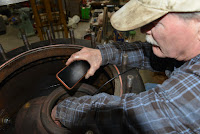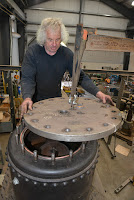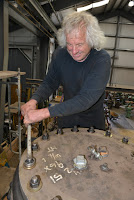 Over the past several weeks, the dry pipe has been "lapped" with the throttle body and the branch pipe manifold, the throttle valve has been lapped, and the components reassembled inside the boiler. (Lapping is the process of grinding and polishing the mating surfaces to allow them to fit together without leaking.) Then the boiler was filled with water to check for leaks. Some minor leaking was detected around several new rivets and some of the new stay bolts, but nothing serious.
Over the past several weeks, the dry pipe has been "lapped" with the throttle body and the branch pipe manifold, the throttle valve has been lapped, and the components reassembled inside the boiler. (Lapping is the process of grinding and polishing the mating surfaces to allow them to fit together without leaking.) Then the boiler was filled with water to check for leaks. Some minor leaking was detected around several new rivets and some of the new stay bolts, but nothing serious. Gary James is a shipwright who usually leads the work on coaches and other wood projects, but he has a very diverse skill set, and some great tools, too. His borescope displays an image on his phone and was inserted into the dry pipe to check for any leaks. He found the assembly leak-free, at least under atmospheric pressure.
Gary James is a shipwright who usually leads the work on coaches and other wood projects, but he has a very diverse skill set, and some great tools, too. His borescope displays an image on his phone and was inserted into the dry pipe to check for any leaks. He found the assembly leak-free, at least under atmospheric pressure. Meanwhile, the copper gasket for the steam dome was annealed by heating it with a torch and quenching it in cold water. This makes the copper soft and prepares it to take shape as the dome lid is tightened down. This thin ring of copper provides the steam seal.
Meanwhile, the copper gasket for the steam dome was annealed by heating it with a torch and quenching it in cold water. This makes the copper soft and prepares it to take shape as the dome lid is tightened down. This thin ring of copper provides the steam seal. Lastly, the dome lid was replaced and tightened down. Machinist Gerry Petitjean did the honors and verified the lid was pulled evenly against the gasket. The water was filled all the way to the top and the last of the air was exhausted so the entire vessel could be inspected for leaks.
Lastly, the dome lid was replaced and tightened down. Machinist Gerry Petitjean did the honors and verified the lid was pulled evenly against the gasket. The water was filled all the way to the top and the last of the air was exhausted so the entire vessel could be inspected for leaks. What is next? In the coming weeks water in the boiler will be heated to around 30 degrees C. Then a small hand pump will be used to raise the pressure in the boiler to approximately 200 psi. This process will identify any remaining leaks, or other issues that need to be addressed. When all the remaining leaks are repaired, the hydro-static test will be repeated for the Federal inspector.
 The Museum is grateful for 4Culture, Washington Heritage Capital Fund, Schwab Fund, Osberg Family Trust, Emery Rail Heritage Trust, Northern Pacific Railway Historical Association, and more than 100 individuals for their support in funding the restoration of the 924.
The Museum is grateful for 4Culture, Washington Heritage Capital Fund, Schwab Fund, Osberg Family Trust, Emery Rail Heritage Trust, Northern Pacific Railway Historical Association, and more than 100 individuals for their support in funding the restoration of the 924.Want to see and learn more? Join us for the Snoqualmie Wine Train on Saturday, April 27 beginning at 2:30 PM in the Snoqualmie Depot. Your Wine Train experience will include a visit to the Conservation and Restoration Center to see locomotive 924.

1 comment:
Awesome and interesting article. Great things you've always shared with us. Thanks. Just continue composing this kind of post. Polished Sapphire Wafers and Substrates.
Post a Comment